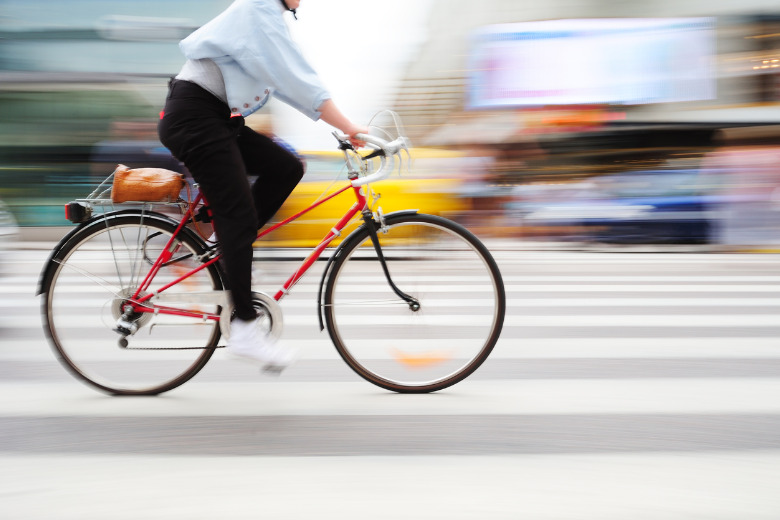
Australia’s lack of safe and accessible bicycle infrastructure means cyclists are often forced to share routes with pedestrians or cars. Councils have favoured quick-fix solutions, like painted-on cycle lanes with little rider protection from cars.
Bicycle networks are often not thoroughly planned out, with lanes ending abruptly at unsafe intersections. The risk of accidents must be managed and places an urgent need to invest in safe cycling infrastructure and the design of complete streets.

In urban design, more prominence is being put on complete streets, which balances the needs of bikes, pedestrians, public transport, delivery vehicles and cars, while also creating attractive destinations.
Our recent Complete Streets projects represent a relatively low-cost, high-value carbon reduction investment.
Some of the most endeared cities around the world, such as Paris and Barcelona, are re-inventing themselves as people-first places, prioritising pedestrians and bikes over cars. Paris recently announced $386 million in funding to add 186 kilometres of protected bike lanes and triple the amount of bike parking in the city.
Six steps to improve Australia’s cycling infrastructure to make it a world leader in bike-friendly cities
1. Prioritise bikes and pedestrians over cars. For too long, cars have been the prioritised mode of transport in Australia. To ensure safer infrastructure that prioritises low-carbon mobility, a 180-degree shift in mindset is needed in the design, management and education around the movement network at all levels of decision making. This ranges from the structure and powers of state agencies, down to the lots of little measures that add up to make a big difference.
2. Address safety. Safety is the biggest barrier causing cycling hesitancy. In fact, an estimated 69 per cent of Australian cycling consumers would be encouraged to ride more if there was an increased feeling of safety while riding with motor traffic. The simple litmus test for any new cycling infrastructure needs to be: is it safe enough for both a 7-year-old child and their 70-year-old grandparent?
3. Close gaps in the cycle network. Cash-strapped councils are often unable to deliver cycle network improvements, and paths often end abruptly or do not provide routes from home to key destinations, such as shops, schools, universities and public transport. These dangerous gaps in the network stop people from making the commute from home to work, school, or the shops. When cycle paths are easy to navigate and well-connected, cycling numbers will increase. Governments need to consider the greater cycling network and how different LGAs intersect, as well as accommodate for a mix of users, including routes for leisure and recreation, exercise and as a mode of transport.
4. Create protected bike lanes. Painted-on bike lanes are the most basic level of infrastructure for government and they often lack protection from fast moving cars. Protected cycle lanes that are separated by physical barriers like parked cars, a curb or landscaping offer a buffer from busy roads. Evidence suggests they also make roads safe for cars too.
5. Use speed to dictate how modes of transport mix. Often cyclists, and particularly e-bikes and e-scooters, are forced to compete for space with pedestrians on already busy pathways. In Australia, e-bike motors are capped at 250 watts and the power cuts out when they hit 25 kilometres per hour. At such a speed, they need to be separated from pedestrians for safety reasons and accommodated on cycle paths, protected bike lanes and on streets where traffic is slow moving. When a cyclist is hit at 45 kilometres per hour or more, they have a 50 per cent chance or less of surviving. But this increases to a 90 per cent chance of survival if they are struck at 30 kilometres per hour.
6. Design for complete streets. Through thoughtful design, complete streets provide safe and accessible mobility for all modes of transport and ability levels, while also beautifying public spaces with greenery and making them more vibrant and appealing. More active transport helps to reduce obesity and improve the mental health of residents, it increases safety for bicyclists and pedestrians, reduces carbon emissions and can stimulate economic growth by creating attractive places with more street activity.
Andrew Brodie is the Senior Urban Designer at urban planning and design practice Hatch RobertsDay
Comment below to have your say on this story.
If you have a news story or tip-off, get in touch at editorial@governmentnews.com.au.
Sign up to the Government News newsletter
I agree that infrastructure is important, but it’s expensive and takes time. The unspoken solution is to educate other road users to respect all other road users, with vulnerability being the key to resolving critical decisions, eg, is it better to brake to avoid a living thing when there is a chance the vehicle could be damaged by another vehicle? In Australia, it seems, life is less valuable than metal and plastic. We need a federal government-led campaign because right now, it seems our attitude (as cyclists) is defeatist, as in things can’t get better for cyclists without massive expenditure on infrastructure. (I agree it’s necessary but so far, there’s not much cause for optimism.) My question is: are attitudes the easiest factor to change, or is this simply unrealistic? In my decades on two wheels I have seen attitudes towards motorcyclists greatly improve, but it’s become far more dangerous to ride my bicycle (by orders of magnitude). Hopefully the cycling community will grasp this year’s world road championships in Wollongong to put safety in a sporting context; this may help non-cyclists understand cyclists are human beings. It could be similar to how Wayne Gardner’s wins at Phillip Island in 1989/90 helped to reset attitudes to motorcyclists which had been badly impacted by the so-called ‘Bathurst riots’ earlier that decade. What followed were campaigns that asked motorists to look out for bikes, the underlying message was that bikes also belonged on the roads. Yes, maybe the only answer is to build the infrastructure because nothing is going to change the attitude of some (or many) Australian road users towards cyclists, but a serious and consistent education campaign to address attitudes could be worth a try in the interim.
Nothing about Australia’s unique cyclist-punishing helmet laws? Surely removing such an obvious and well-documented[1] barrier to entry would be on this list.
[1] A full 30% of respondents would ride more without helmet laws, according to the Bicycle Network review.
Tom S.
Firstly lets get the bike infrastructure safer!!!
I think I am a reasonably competent regular cyclist and over the years I have had two significant crashes that would have been avoided with better bike infrastructure. Neither were at high speed, nor bad weather.
In one my helmet was cracked because of a nearby obstruction. So without helmet I would have had a serious head injury.
The cycle lobby and transport agencies often in my opinion don’t help themselves – cities are heavily contested spaces and cyclist behaviour in Australia is simply not like Amsterdam or Copenhagen – they will gleefully advocate for the removal of essential walking / city amenity like trees or alfresco to try and meet dubious gold plated best practice protected lane standards even though these are used more than the cycling mode when by your own research simply reducing the speed for all modes to 30km could far better change behaviour over time – this inflexibility means the gold standard rarely happens and if it does it’s often a disaster that never gets repeated – and I’m a cyclist
Being a cyclist myself I agree with a lot of the above , helmets are a lot like seat belts we will get used to them and like seat belts they do save lives. I know a lot of drivers think cyclists are a menace on the roads but we should all share and come home safely, however groups of riders four abreast is not ok on the roads.